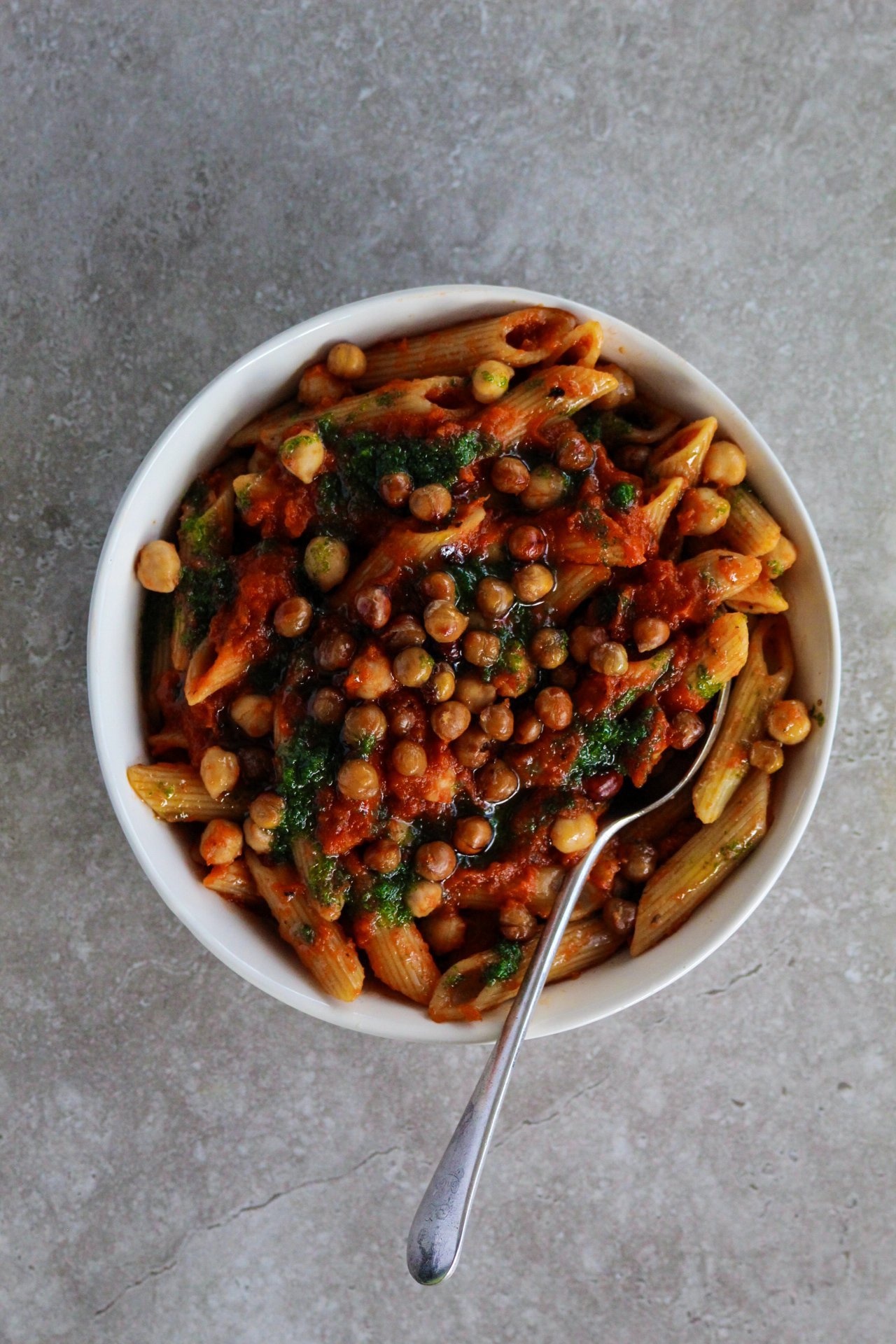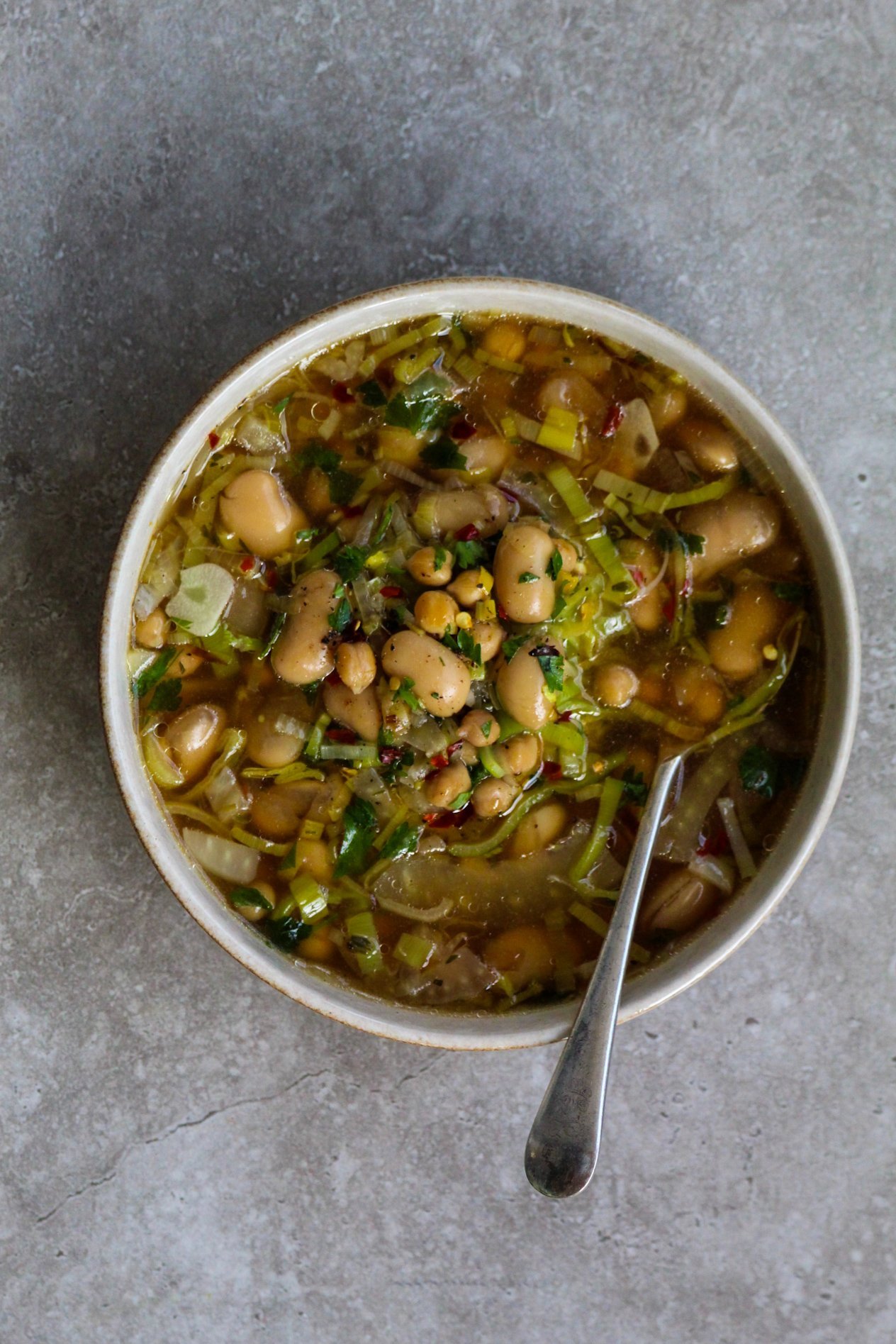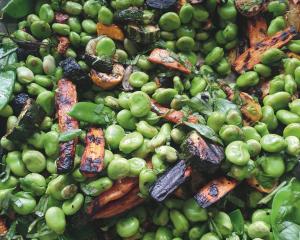
I want to share with you easy tips to bring the grocery bill down and apply them in three delicious recipes. They are cheap and nutritious without sacrificing flavour, and were cooked up on a student budget, so you know they are legit.
Here are my tips to budget-friendly cooking this winter.
 Shop around to find the best deals
Shop around to find the best deals

Grosave is a grocery shopping list app I like to use to compare supermarket prices. The Indian Food Mart has great deals for spices, Veggie Boys often have cheap specials on produce, and there are plenty of Asian shops around Dunedin for rice, noodles, lentils and Asian sauces.
Shop seasonally
The farmers market always has cheap seasonal vegetables; massive pumpkins for $4, huge bunches of silverbeet for $3, and mixed veggie bags for $6. Compared with a single capsicum costing $5 at the supermarket, it’s an easy way to save money. Chop them up and freeze them when you get home to ensure they don’t go to waste.
Grow your own herbs
Herbs are easy enough to keep alive and bring so much more flavour than their dried counterparts. If you are short on space, try growing them in pots. Keep them on your windowsill or close to your kitchen door for easy watering and picking.
Forage for greens
This is a great way to get outside during these frosty days. Start in your backyard, and make sure to only pick what you know. Dandelion and miners lettuce are easy to identify and can be used anywhere you would use leafy greens. Onion weed is an excellent spring onion substitute, and most gardens have a rosemary bush hiding somewhere.
If you’re after more herbs, the Living Campus at Otago Polytechnic is full of thyme, parsley and sage free for public use.
Make your own stock
This is an easy way to save money, waste less and improve upon store bought. Simply save any bones and vegetable scraps from your cooking prep in the freezer until you have enough to fill a large pot. Chicken carcasses, pork or beef bones, onion skins, carrot ends, celery leaves and parsnip peel all work well. When you have a good amount, place scraps in a large pot and cover with cold water.
Add some peppercorns, bay leaves, and a few cloves of garlic.
Bring to the boil, then turn down the heat and simmer for a couple of hours until reduced and flavourful. Strain and cool, then freeze.
Use every part of ingredient
Add broccoli stems to dinners, save carrot tops for pesto, cauliflower leaves for salad. If a recipe calls for lemon juice, zest first; that’s where all the flavour is kept. Reuse pickle juice to make pickled onions or to flavour sauces.
Cook in bulk
This is much cheaper and easier than trying to make a single serving; it’s hard to know what to do with the remainder of a can of tomatoes.
Freeze leftovers as individual portions for easy meals on hand.
Stretch meals further with lentils and beans
Try adding canned lentils to mince, and canned beans to soups and salads. Chickpeas are great to blend into sauces or dips for added fibre or roasted for a crunchy topping (see below recipe).
Invest in staple flavour bombs
These are low-effort, high-impact ingredients that you reach for frequently to transform a dish.
Mine are soy sauce, lemons, red curry paste, and chicken stock powder, but use what works for you.
Elevated tomato pasta
We’re all familiar with a classic tomato pasta, but this recipe takes it up a notch. A from-scratch sauce triples the flavour, and simple garnishes take it from a basic weeknight meal to a luxurious dinner (on a budget!). Throw in your favourite veges to bulk it out even further or try topping it with crispy bacon; it’s an endlessly adaptable dish that pleases even the fussiest eaters.
Cooking time 45min
Serves 8
Cost per serve $1.03
For the pasta:
1 Tbsp sunflower oil
1 large brown onion, finely chopped
1 large carrot, grated
3 cloves garlic, finely chopped (or 1 tsp
crushed garlic)
1 handful foraged herbs, finely chopped
(parsley, rosemary, thyme and sage
all work well)
1 tsp dried oregano
1 tsp smoked paprika
½ tsp freshly cracked black pepper
2 x 400g can tomato puree
1 x 400g can chickpeas, drained
and rinsed
800ml water
1 Tbsp salt
500g cooked pasta (penne, fusilli and
spaghetti are great options)
For the crispy chickpeas:
1 x 400g can chickpeas, drained, rinsed
and patted dry
1 Tbsp sunflower oil
1 tsp smoked paprika
½ tsp salt
½ tsp freshly cracked black pepper
For the foraged green oil:
¼ cup sunflower oil
1 small handful of foraged herbs and
greens, roughly chopped (parsley,
onionweed, chives, and nettle are all
lovely)
½ tsp salt
For the pasta:
Heat the oil in a large saucepan over medium heat. Add the onion, carrot and garlic in the pan and fry for about eight minutes, stirring occasionally, until softened and golden. Add the foraged herbs, oregano, paprika and pepper and fry for a further two minutes until fragrant.
Add the tomatoes, chickpeas, water, and salt, then bring to the boil. Lower the heat and simmer until reduced by half, about 30 minutes.
Stir the cooked pasta through the sauce, then serve in a bowl with a handful of crispy chickpeas and a drizzle of foraged green oil.
For the crispy chickpeas:
Preheat the oven to 220°C bake.
Combine the chickpeas, oil, paprika, salt and pepper on a lined baking tray and toss until evenly coated.
Bake for 20-30 minutes until crispy and golden brown. Watch carefully in the last 10 minutes of cooking, as they burn quickly.
For the foraged green oil:
In a high-speed blender, combine the oil, foraged greens, and salt.
Blend on high until the ingredients are completely smooth.
Notes:
• Try changing up the flavour of the chickpeas; cumin and coriander work well together.
• If you don’t have a high-speed blender you can use a stick blender or mortar and pestle to blend the herb oil, however it won’t be quite as smooth. Alternatively, you can try finely chopping your greens, then use the flat of your knife to crush them on a chopping board with sprinkle of salt. This technique is often used to turn garlic cloves into a paste. Then mix with the oil, omitting the salt, and you should be left with a textured green oil.

Leek, fennel and white bean soup
This soup may seem like an unlikely combination, but it’s become my go-to over the past year. Gently softening the leek, fennel and garlic in oil mellows their flavours and enhances their sweet notes. When combined with a bright hit of lemon, it makes for an irresistible soup. Another reason to love this dish is its use of pantry items.
Cooking time 40min
Serve s6
Cost per serve $1.50
Ingredients
1 Tbsp sunflower oil
1 large leek, white and light green parts only, thinly sliced
1 small fennel bulb, thinly sliced
5 cloves garlic, thinly sliced (or 1 Tbsp crushed garlic)
1 tsp finely chopped fresh rosemary
1 tsp finely chopped fresh thyme
1 tsp finely chopped fresh parsley
½ tsp chilli flakes
1 x 400g can chickpeas
1 x 400g can white beans
1 litre chicken stock
1 Tbsp soy sauce (to deepen the flavour)
1 tsp salt
2 bay leaves
Zest and juice of 1 lemon
Sunflower oil, to drizzle
Chilli flakes, to sprinkle
Roughly chopped parsley, to sprinkle
Method
Heat the oil in a large saucepan over medium heat. Add the leek, fennel and garlic, cover and cook until softened, about 8 minutes. Add the herbs and chilli flakes then cook for a further 2 minutes, stirring occasionally, until soft and fragrant.
Pour both cans of beans, liquid included (as this gives the soup body) into the saucepan and add the chicken stock, soy sauce, salt, and bay leaves. Bring to the boil then reduce the heat and simmer for 15 minutes.
Remove and discard bay leaves and stir through lemon zest and juice. Finish with a drizzle of sunflower oil and a sprinkle of chilli flakes and parsley. Serve with crusty bread or fluffy dinner rolls (recipe in my previous article).
Notes:
• Any white beans will work here. I prefer butter beans for their larger size compared with chickpeas as they bring a lovely textural contrast, but you could use cannellini beans or more chickpeas.
• Throw in some shredded chicken and foraged greens to turn this soup into a fuller meal.

Dal for days
Dal is one of those meals that everyone should know how to make. Simple, comforting, and extremely economical, it’s great for feeding heaps of people with minimal effort.
Cooking time 45 min
Serves 10
Cost per serve $0.67
Ingredients
1 Tbsp sunflower oil
1 large brown onion, diced
3 cloves garlic, finely chopped (or 1 tsp crushed garlic)
2cm piece ginger, finely chopped
1 Tbsp garam masala
1 Tbsp curry powder
2 Tbsp Thai red curry paste
1 x 400g can coconut cream
1 x 400g can tomato puree
300g red lentils
1kg pumpkin, chopped into 2cm cubes
800ml water
1 Tbsp salt
1 big bunch greens, roughly chopped (about 500g; silverbeet, spinach, watercress, and dandelion all work well)
2 Tbsp fish sauce (can substitute soy sauce if vegetarian)
¼ cup apple cider vinegar
Coriander leaves, to garnish
Method
Heat the oil in a very large saucepan over medium heat. Place the onion, garlic, and ginger in the pan and fry, stirring occasionally, until golden and softened.
Add the garam masala and curry powder, then fry for one minute. Add the red curry paste and fry, stirring constantly, for two minutes until it begins to stick to the saucepan.
Reserve two tablespoons of the coconut cream then pour the remainder into the saucepan. Heat aggressively for five minutes until the oil separates.
Add the tomatoes, lentils, pumpkin, water and salt, then bring to the boil. Reduce the heat and simmer for 30 minutes, stirring occasionally, until pumpkin is tender and lentils are soft and broken down.
Remove from the heat and stir in the foraged greens. Cover and allow to wilt.
Finish with the fish sauce and vinegar. To serve, ladle dal into bowls and garnish with a drizzle of the reserved coconut cream and coriander leaves. Serve with basmati rice.
Notes:
• Adapt this recipe to use what you have; try leek instead of onion, replace pumpkin with kumara or carrots, and flavour with spices you already have.
• For a Balinese twist, replace the Thai red curry paste with two tablespoons of Balinese sauce or bumbu Bali (I call it magic sauce, recipe in ODT June 18), use two cans of coconut cream and one of tomatoes, and garnish with fried shallots and fresh sambal.
• Top with crispy chickpeas (see pasta recipe for instructions) and garlic yoghurt and serve with roti or naan for an Indian-inspired meal.












